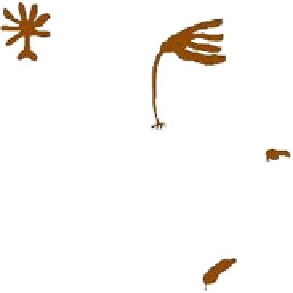Biology Reference
In-Depth Information
0
0.59
2
Strong decrease in
zoospore viability
(poss
i
ble
DN
A da
m
age)
7
0.28
Upper limit of
kelps
12
17
Saccorhiza
polyschides
22
Laminaria
ochroleuca
Phyllariopsis
brevipes
27
0.012
Lower limit of UV-B penetration
(0.1% I
0
)
32
0.001
37
Phyllariopsis
purpurascens
42
Fig. 15.3
Zonation of the four kelps at Tarifa (Strait of Gibraltar) and its correlation to the
prevailing vertical ultraviolet-B radiation conditions and major biological and bio-optical events,
expressed as biologically effective ultraviolet-B doses for DNA damage (BED
DNA-300
) assuming
constant photon fluence rates during 8 h (Wiencke et al.
2000
)
the Atlantic. The surface current of Atlantic water flows close to the shores of the
Iberian Peninsula and then it turns around, like an anticyclone, in the Western
Alboran Sea. Simultaneously, upwelling of cold, deep water close to the shores
compensates for the accumulation of water by the action of the anticyclone
(Lacombe and Tchernia
1972
; Rodr´guez
1982
; Sarhan et al.
2000
).
The kelp forests are located in the Strait of Gibraltar, in the cold and nutrient-rich
upwelling zones close to the South Iberian Peninsula, similar as in other kelp
regions worldwide (Druehl
1981
; Bolton
2010
; Steneck et al.
2002
) and at Alboran
Island. Because of the high number of sunny days in the Mediterranean and the high
light transmittance of the clear water, kelp forests are confined to deep water as a
consequence of the photoinhibitory effects of the strong irradiance in shallow water
(see Fig.
15.3
). Moreover, surface temperatures
22
C in summer also contribute
to the restriction in depth because these high temperatures are at the edge of thermal
limits for the kelp species inhabiting Alboran Island (see Table
15.1
).
>


















